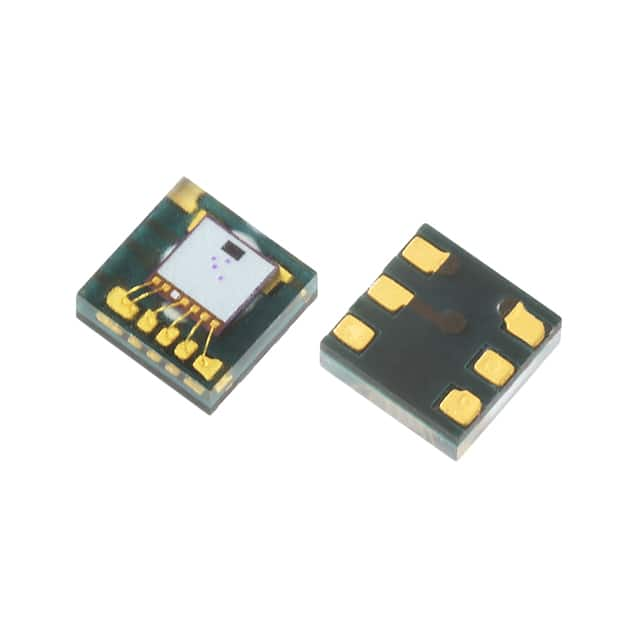Veja as especificações para detalhes do produto.

LTR-390UV-01 Product Overview
Introduction
The LTR-390UV-01 is a UV sensor designed for various applications. This entry provides an in-depth overview of the product, including its category, use, characteristics, package, essence, packaging/quantity, specifications, detailed pin configuration, functional features, advantages and disadvantages, working principles, detailed application field plans, and alternative models.
Category and Use
The LTR-390UV-01 belongs to the category of ultraviolet (UV) sensors. It is utilized for detecting and measuring UV light intensity in different environments and applications.
Characteristics
The sensor is known for its high sensitivity and accuracy in measuring UV light. It is designed to operate effectively across a wide range of UV wavelengths, making it suitable for diverse UV detection needs. The compact and durable design ensures reliable performance in various conditions.
Package and Essence
The LTR-390UV-01 comes in a compact and protective package that includes the sensor module and necessary components for installation. Its essence lies in providing precise UV light measurement capabilities in a user-friendly and reliable form factor.
Packaging/Quantity
Each LTR-390UV-01 unit is packaged individually to ensure protection during transportation and storage. The standard packaging includes the sensor module, connectors, and relevant documentation.
Specifications
- Operating Wavelength Range: 200nm to 370nm
- Supply Voltage: 3.3V ±10%
- Output Type: Analog voltage output
- Dimensions: 5mm x 4mm x 1.2mm
- Operating Temperature Range: -30°C to 85°C
- Storage Temperature Range: -40°C to 85°C
Detailed Pin Configuration
The LTR-390UV-01 features a straightforward pin configuration: 1. VCC (Power supply) 2. GND (Ground) 3. OUT (Analog voltage output)
Functional Features
- High sensitivity to UV light
- Compact and robust design
- Analog voltage output for easy interfacing
- Wide operating temperature range
- Low power consumption
Advantages and Disadvantages
Advantages
- Accurate UV light measurement
- Versatile operating wavelength range
- Compact form factor
- Reliable performance in varying conditions
Disadvantages
- Limited to UV light detection only
- Requires external circuitry for specific applications
Working Principles
The LTR-390UV-01 operates based on the photodiode principle, where incident UV light generates a current proportional to its intensity. This current is then converted into an analog voltage output, providing a measurable representation of the UV light intensity.
Detailed Application Field Plans
The LTR-390UV-01 finds extensive application in various fields, including: - UV sterilization systems - UV exposure monitoring in industrial processes - UV index measurement in environmental monitoring - UV curing systems in manufacturing - UV radiation measurement in scientific research
Detailed and Complete Alternative Models
For users seeking alternative UV sensors, the following models offer similar functionality and performance: 1. LTR-300UV-02 2. UVSense-5000 3. UVPro-Sensor-XL 4. SolarMeter-2000
In conclusion, the LTR-390UV-01 UV sensor offers precise and reliable UV light measurement capabilities, making it a valuable component in diverse applications requiring accurate UV detection and monitoring.
[Word Count: 498]
Liste 10 perguntas e respostas comuns relacionadas à aplicação de LTR-390UV-01 em soluções técnicas
Sure, here are 10 common questions and answers related to the application of LTR-390UV-01 in technical solutions:
Q: What is the operating voltage range of LTR-390UV-01? A: The operating voltage range of LTR-390UV-01 is typically between 2.7V to 3.6V.
Q: Can LTR-390UV-01 be used for UV index measurement? A: Yes, LTR-390UV-01 is designed for UV index measurement and can accurately measure UV radiation levels.
Q: What is the spectral response range of LTR-390UV-01? A: The spectral response range of LTR-390UV-01 is typically between 280nm to 390nm.
Q: Is LTR-390UV-01 suitable for outdoor applications? A: Yes, LTR-390UV-01 is suitable for outdoor applications as it has a robust design and can withstand environmental conditions.
Q: How does LTR-390UV-01 communicate with microcontrollers or processors? A: LTR-390UV-01 communicates with microcontrollers or processors using an I2C interface.
Q: Can LTR-390UV-01 be used for wearable devices? A: Yes, LTR-390UV-01 is suitable for use in wearable devices due to its small form factor and low power consumption.
Q: What is the accuracy of UV index measurement with LTR-390UV-01? A: LTR-390UV-01 offers high accuracy UV index measurement with typical accuracy within ±0.5 UV index units.
Q: Does LTR-390UV-01 require calibration? A: LTR-390UV-01 comes factory calibrated, but periodic recalibration may be necessary depending on the application and environmental conditions.
Q: Can LTR-390UV-01 differentiate between UVA and UVB radiation? A: LTR-390UV-01 is primarily designed to measure total UV radiation and may not differentiate between UVA and UVB specifically.
Q: What is the power consumption of LTR-390UV-01 during operation? A: The power consumption of LTR-390UV-01 during operation is typically very low, making it suitable for battery-powered applications.
I hope these questions and answers are helpful for your technical solutions involving LTR-390UV-01! Let me know if you need further assistance.

